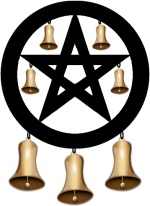From Pagan bells to Church bells
A bell makes a sound – you probably knew that already. And that sound often has a profound meaning.
Even bells that are not rung may have great importance. For example, the Liberty Bell in Philadelphia, USA, symbolises the nation's
- 20th century Cold War icon of God Bless America (and nobody else)
- 19th century abolition of slavery (in statute only)
- 18th century independence from Britain (and Britain's glee at the disassociation)
and even before that, a religious use of bells began in Paganism and has since been adopted by the Christian Church.
Church bells and their link to Paganism

Cathedral Church of Saint Matthew, Dallas, USA
(Photo by Sarum Blue, 2006)
Anyone who lives near a church with zealous bell ringers, who behave like latter-day Quasimodos, will know every Sunday morning that they make a bell-of-a-lot-of noise.
That's what bells are supposed to do; make a noise. They can even frighten grizzly bears.
In both secular use and religious use, bells are used to make an announcement.
Non-religious use includes
- signalling when fire breaks out or some other calamity, or on buoys near rocks and shallow water;
- in less enlightened times, victims of plaque and leprosy rang a bell to warn people to keep a good distance
- announcing the time, such as waking you up for work.
Again!
In religion too, bells are used to announce the time. In Christianity the bell is rung to announce various important events, including:
- the time to worship;
- the impending consecration of the bread and wine;
- the announcement of a wedding, funeral or remembrance service.
In Augusti's Antiquities of the Christian Church we read that bells ...
"...were unknown to the Hebrews, Greeks and Romans. Even if the tintinnabula of the Romans were bells, they were very inconsiderable in comparison with church-bells of later date. These were not in use earlier than the seventh century. The most probable opinion is that which ascribes the first introduction of them to Sabianus bishop of Rome, who succeeded Gregory the Great in the year 604.* In the seventh and eighth centuries they were in common use in the churches in France. Near the close of the ninth century the church of St. Sophia at Constantinople was furnished with bells.**"
* Polydorus Vergil. De invent, rer. lib. vi. c. 11: Centur. vi. c. 6: Hospinian. de orig. tempi, lib. ii. c. 26.
** Baron. Annales A. D. 865
So bells didn't come from ancient Paganism into Christianity immediately. But there is a strong link, as we'll see below.
Other religions, for example Buddhism, also use the bell to mark certain stages of a religious ceremony.
Buddhism
Photo of Tokokji (Buddhist) temple bell in Meguro-ku, Tokyo. (Click photo to enlarge or click here for a close-up.)
In Japan the kane ("kanny") doesn't ring or chime like a European church bell, rather it has a deep bo-o-o-om. The particular shape and construction create very low-frequency vibrations when struck.
At midnight on New Year's Eve, the kane is struck very slowly 108 times for the vibrations to carry away the 108 worldly desires that we suffer from. In other words, cleanse people of the sins committed in the past year, so people can start with a clean spirit for the New Year.
These 108 naughties include the Seven Deadly Sins and also a few vices that are not so bad. However we interpret them, and although 108 is quite a lot, they are not all-encompassing. It's difficult to pinpoint which of the 108 evils covers some of today's temptations, such as driving your car too fast, becoming addicted to tobacco, and other things that we know are "bad".
When the kane is tolled 108 times the vibrations themselves are not believed to carry away any impurities; they are just announcements, spaced by a minute or so, for the faithful to reflect on each temptation and release it.
Shintoism
Photo of Nishikubohachiman (Shinto) shrine bell in Minato-ku, Tokyo. (Click photo to enlarge or click here for a close-up.)
A main tradition in Japan is Shintoism, which has many similarities to European folk religions.
The sound from a Shinto bell (suzu) is more of a rattle than a ring, chime or boom. The first time you shake its rope you can be forgiven for thinking you've broken it!
But forgiveness is not the purpose of the suzu. It is shaken to beckon the gods to hear your prayers. This is similar to other religions making an announcement with the word Amen.
Paganism

Wiccans believe that these Seven bells, hung from a sacred encircled pentagram, vibrate with the power of the bells' female nature. Yes female, and we'll see why, below.
Thousands of years ago bells would have been useful for civil authorities to announce the opening of a market or baths. And for religious purposes, the bell could have announced the number of days before a solstice, some other festival or ceremony.
For the bell to have made such announcements, somebody would have shaken it or used some other implement to strike it to generate the vibrations. There is no evidence to suggest that bells rang by themselves, neither can we find evidence that Pagan traditions considered bells were possessed by magical forces (except in fictional literature, such as Papageno's magic bells in Mozart's The Magic Flute).
Bells might have been rung to drive out evil spirits, especially in mid-winter, much in the same way as Christians have the mid-winter tradition to welcome the spirit of Christmas. But in both religions, the bell is just an audible expression of what is in somebody's heart and mind.
There is also at least one old custom using bells that Thomas Inman (1820–1876) suggests has worked its way into religion. In his book Ancient Pagan and Modern Christian Symbolism we read:
The bell was of old a symbol of virginity, for Eastern maidens wore them until marriage (see Isa. iii. 16). The origin of this custom was the desire that every maiden should have at her marriage, or sale, that which is spoken of in the Pentateuch as "the token of virginity." It was supposed that this membrane, technically called "the hymen" might be broken by too long a stride in walking or running, or by clambering over a stile or wall. To prevent such a catastrophe, a light chain or cord was worn, under or over the dress, at the level of the knees or just above. Its length only permitted a short step and a mincing gait. Slight bells were used as a sort of ornament, and when the bearer was walking their tinkling was a sort of proclamation that the lady who bore them was in the market as a virgin. After "the flower" had been plucked, the bells were no longer of use.
So although we often hear church wedding bells to announce the marriage of a new couple, in Paganism the bells symbolised virginity, and by extension, childbirth.
Even those having a PhD in gynaecology and bearing witness to the birth of thousands of people, they still consider childbirth as nothing short of a miracle; something so natural, yet supernatural.
It is no surprise therefore that the bell has found its way into religion. It is symbolic of the female nature, virginity and reproduction, not just in Paganism but in many of the main religions.
Mystical properties of bells?
Rather than ancient religions believing bells had mystical properties, it's more likely that Christians were the ones who elevated the humble bell to that level.
The practice of consecrating bells through a blessing ceremony became popular in the Middle Ages. The ceremony includes the use of salted water and unction of holy oil, and the bell even receives a name. (The tradition continues to this day but is no longer baptised, since a bell is not believed to have any soul.)
In The Antiquities of the Christian Church we read that...
...the bell was considered as a sacred and indispensable appendage of a church. The following is a specimen of the inscriptions which were frequently written upon the church bell:
"Laudo Deum verum, plebem voco, congrego clerum, Defunctos ploro, nitnbum [al. pestem] fugo, festaque honoro." (To praise God, to call the people, to call the clergy, to bewail the dead, to banish plague, to honour festivals)
The custom of consecrating and baptizing bells is a superstition of early date, perhaps as early as the eighth century; that of naming the bells of churches, dates no further back than the tenth or eleventh century.
The tolling of bells at the decease of a person, and at funerals, was originally an expedient of a superstitious age, to frighten away demons that were supposed to be hovering around to prey upon the spirit of the dead or dying man. This superstition was widely extended during the dark ages. Bells were often rung with violence, also, during a tempest, to frighten away demons and avert the storms which they were supposed to raise.
Ed. Encycloped. Art. Bells.
¶ It should be of little interest to Christians what Pagans may or may not have believed, or still believe, about magic and bells.
It's clear that Pagans, Buddhists and many other religions use bells, which doesn't make their similar use by Church bell ringers a Pagan activity, any more than praying, singing praises, reading Scriptures, etc. As Psalm 95:1 instructs, we should praise God "with joyful noise".
But I do empathise with you if you live next door to a church with over-zealous bell ringers.
See other Pagan items adopted by Christianity.
"very slowly" means very slowly; about once every minute or so. Thus it can be around 2 a.m. before people living nearby can get to sleep!
For example, "ambition", "obsession" and "stubbornness" are included as impure, yet paradoxically, Buddhists stubbornly and obsessibly strive to fulfill their ambition of nirvana. Others include "dissatisfaction", "hatred" and "anger", yet Buddhists should not be satisified with their attempts to love others and to hate evil.
The real meanings are perhaps lost in translation, which is why some of the 108 temptations appear to be duplicates; for example, deceit & deception, disrespect & disrespectfulness.
Or mid-summer, for people such as us in Australia

